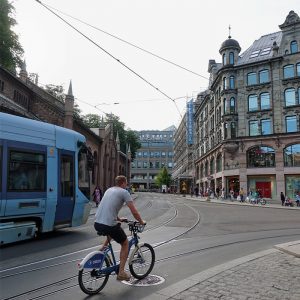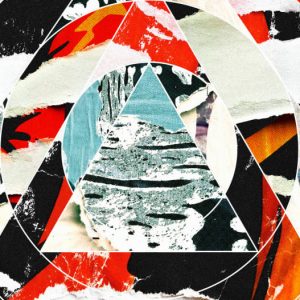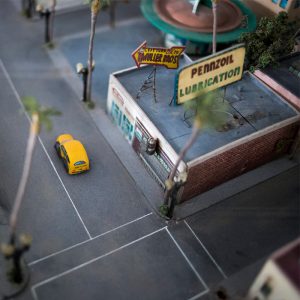Link About It: This Week’s Picks
Manhattan’s “Phallus Palace,” Oslo’s move become car-free, snow season apps and more in our journey through the internet

Oslo Moves to Become a Car-Free City
 In an effort to make its downtown more pedestrian- and cyclist-friendly, Oslo will remove the couple hundred remaining parking spots left in its city center. The development aims to turn the most heavily trafficked areas into to car free zones to limit congestion, reduce pollution and make the city more walkable. Other cities have launched similar initiatives with slight public resistance but quite positive results—in Paris, a test run of a similar restriction dropped nitrogen dioxide levels by 25% and noise by 20%. “A couple of decades ago, it was perfectly normal to smoke cigarettes inside,” Hannah Elise Marcussen, Oslo’s vice mayor for urban development, told the New York Times. “Today, very few would do that. I think it’s the same with cars in the city center. One day we will look back and ask ourselves why we ever thought that was a good idea.” Read more at the Times.
In an effort to make its downtown more pedestrian- and cyclist-friendly, Oslo will remove the couple hundred remaining parking spots left in its city center. The development aims to turn the most heavily trafficked areas into to car free zones to limit congestion, reduce pollution and make the city more walkable. Other cities have launched similar initiatives with slight public resistance but quite positive results—in Paris, a test run of a similar restriction dropped nitrogen dioxide levels by 25% and noise by 20%. “A couple of decades ago, it was perfectly normal to smoke cigarettes inside,” Hannah Elise Marcussen, Oslo’s vice mayor for urban development, told the New York Times. “Today, very few would do that. I think it’s the same with cars in the city center. One day we will look back and ask ourselves why we ever thought that was a good idea.” Read more at the Times.
Design Predictions for 2019
 According to experts (from Microsoft, ADAY, Google, Ideo and more), design themes for next year will be more personal—in part as a backlash to people being “mere data points” in recent years. From products becoming more conscious and personalized to a shift away from “emotionally subdued design,” 2019 is looking to be a little more about humans. Read about the nine predictions at FastCo.
According to experts (from Microsoft, ADAY, Google, Ideo and more), design themes for next year will be more personal—in part as a backlash to people being “mere data points” in recent years. From products becoming more conscious and personalized to a shift away from “emotionally subdued design,” 2019 is looking to be a little more about humans. Read about the nine predictions at FastCo.
The Farthest Known Object in Our Solar System is Pink
 Nicknamed Farout (but formally known as 2018 VG18) a pink-hued space object has been discovered orbiting the sun. It’s 22 billion miles further away than the second-most distant known object—and it takes more than 1000 years to complete an orbit. Not much else is known except that it’s roughly 310 miles across and spherical. Read more about the dwarf planet, its discovery and how it came to be so far out over at Mashable.
Nicknamed Farout (but formally known as 2018 VG18) a pink-hued space object has been discovered orbiting the sun. It’s 22 billion miles further away than the second-most distant known object—and it takes more than 1000 years to complete an orbit. Not much else is known except that it’s roughly 310 miles across and spherical. Read more about the dwarf planet, its discovery and how it came to be so far out over at Mashable.
2018 Welcomed a New Fleet of Internet Pop Stars
 Forget the pop stars of years past, because 2018’s class of chart-toppers is more diverse, based in subculture and digitally inclined than ever before. Partly because of the new rules on streams counting in chart calculations, many newer musical artists are being born from internet followings and Soundcloud pages. Not only that, but the sound of pop is changing—using more and more elements from various genres from latin trap to k-pop. In their graphic-assisted story, The New York Times explains, “Pop, the genre, is no longer pop.” Find out more there.
Forget the pop stars of years past, because 2018’s class of chart-toppers is more diverse, based in subculture and digitally inclined than ever before. Partly because of the new rules on streams counting in chart calculations, many newer musical artists are being born from internet followings and Soundcloud pages. Not only that, but the sound of pop is changing—using more and more elements from various genres from latin trap to k-pop. In their graphic-assisted story, The New York Times explains, “Pop, the genre, is no longer pop.” Find out more there.
A Visual History of Anchor Brewing’s Christmas Beer
 Dating back to 1975, Anchor Brewing’s Christmas Ale arrives in mid-November and disappears by early January every year. Though consistent in style, the recipes and labels change annually. Regarding the latter, artist Jim Stitt chooses a new seasonal tree to hand-draw. As for the former, the recipe shifts its spice profile. The beer is an exemplary display of craftsmanship and holiday spirit. Some even cellar the previous years’ releases to imbibe in festive vertical tastings. To celebrate the 43rd year of the traditional ale, Anchor made a digital tour that follows the label’s visual evolution chronologically through the years. See where the traditional began, how it has changed and which trees have been fortunate enough to grace the famously stubby bottle.
Dating back to 1975, Anchor Brewing’s Christmas Ale arrives in mid-November and disappears by early January every year. Though consistent in style, the recipes and labels change annually. Regarding the latter, artist Jim Stitt chooses a new seasonal tree to hand-draw. As for the former, the recipe shifts its spice profile. The beer is an exemplary display of craftsmanship and holiday spirit. Some even cellar the previous years’ releases to imbibe in festive vertical tastings. To celebrate the 43rd year of the traditional ale, Anchor made a digital tour that follows the label’s visual evolution chronologically through the years. See where the traditional began, how it has changed and which trees have been fortunate enough to grace the famously stubby bottle.
The Future Interfaces Group is Designing the Everyday Devices of Tomorrow
 There’s a lapse in smart technology where human context and cues exist in real life. Things like gestures, expressions, noises and secondary movements are all missed by tech that can only respond to vocal commands and touch. In the Future Interfaces Group lab, located just off Carnegie Mellon University’s campus, the devices of tomorrow—ones that can detect when you’re sawing, cooking or even tuning a guitar, and give you instructions or feedback—are being developed to shorten the gap between humans and computers. Whether it be wearable tech that allows you to control televisions, dimmer lights and more with the twist of your wrist or the pinching of two fingers or LIDAR technology that can turn any surface into a touchscreen, the lab is focusing their efforts on real-life applications for the newest technology. Read more about the innovative devices and watch the video at Engadget.
There’s a lapse in smart technology where human context and cues exist in real life. Things like gestures, expressions, noises and secondary movements are all missed by tech that can only respond to vocal commands and touch. In the Future Interfaces Group lab, located just off Carnegie Mellon University’s campus, the devices of tomorrow—ones that can detect when you’re sawing, cooking or even tuning a guitar, and give you instructions or feedback—are being developed to shorten the gap between humans and computers. Whether it be wearable tech that allows you to control televisions, dimmer lights and more with the twist of your wrist or the pinching of two fingers or LIDAR technology that can turn any surface into a touchscreen, the lab is focusing their efforts on real-life applications for the newest technology. Read more about the innovative devices and watch the video at Engadget.
Outside Magazine Recommends Seven Apps to Have The Best Ski Season
 To reduce friction from ski season—whether that be through guidance on accumulation patterns, snagging last-minute flights or even tracking storms—smartphone apps are the new must-have accessories to maximize one’s efforts on the slopes. Outside Magazine has compiled a list of the top seven, including OpenSnow, Liftopia, Fatmap and some unexpected additions. For both beginners and experts alike, digital tools can now offer the clearest insight to remove guesswork and emphasize the joy of the experience. Head over to Outside to learn more.
To reduce friction from ski season—whether that be through guidance on accumulation patterns, snagging last-minute flights or even tracking storms—smartphone apps are the new must-have accessories to maximize one’s efforts on the slopes. Outside Magazine has compiled a list of the top seven, including OpenSnow, Liftopia, Fatmap and some unexpected additions. For both beginners and experts alike, digital tools can now offer the clearest insight to remove guesswork and emphasize the joy of the experience. Head over to Outside to learn more.
Art Collector’s Manhattan “Phallus Palace”
 Charles Leslie (art collector and founder of Leslie-Lohman Museum of Gay and Lesbian Art, among other things) has an apartment in Manhattan that’s full of homoerotic art. It’s so full that it’s been dubbed the Phallus Palace. From site-specific murals to ancient artifacts, sculptures, souvenirs, embroidered cushions, tapestries, photography, painting and beyond, it’s a treasure trove that has every inch of the walls and tables and plenty of floor space covered. Leslie—who is also an activist—began the collection in the 1950s and says, “It seems strange to people now, but one of the impulses behind our collection was simply political.” At a time when gay imagery was evident predominantly in porn, he says, “Anything specifically male-oriented still had this tincture, this stain of something obscene about it… Why should the penis be so terrifying to everybody?” Take a look inside the wonderland and find out more at Artsy.
Charles Leslie (art collector and founder of Leslie-Lohman Museum of Gay and Lesbian Art, among other things) has an apartment in Manhattan that’s full of homoerotic art. It’s so full that it’s been dubbed the Phallus Palace. From site-specific murals to ancient artifacts, sculptures, souvenirs, embroidered cushions, tapestries, photography, painting and beyond, it’s a treasure trove that has every inch of the walls and tables and plenty of floor space covered. Leslie—who is also an activist—began the collection in the 1950s and says, “It seems strange to people now, but one of the impulses behind our collection was simply political.” At a time when gay imagery was evident predominantly in porn, he says, “Anything specifically male-oriented still had this tincture, this stain of something obscene about it… Why should the penis be so terrifying to everybody?” Take a look inside the wonderland and find out more at Artsy.
The Careful Restoration of Miniature Hollywood
 A $250,000 miniature project from the ’30s, helmed by a cabinetmaker and his team, is being carefully restored solely by conservator Donna Williams. Williams, who specializes in architectural materials, is carefully cleaning the 450 to scale buildings, on a plot which measures out at 11 by 12 feet. What was once a 25 person project—accompanied by a nationwide tour that left some of the buildings destroyed, mangled and even stolen—is now left for one. And she’s working diligently to outpace the real world development plans that may scrape some of the most beautiful buildings in the miniature from their real-life locations. The tiny, toy-like depiction may have its own misfortunes, but it may soon be the last-standing embodiment of Hollywood as it was back then. See more of the miniature’s fine details at Atlas Obscura.
A $250,000 miniature project from the ’30s, helmed by a cabinetmaker and his team, is being carefully restored solely by conservator Donna Williams. Williams, who specializes in architectural materials, is carefully cleaning the 450 to scale buildings, on a plot which measures out at 11 by 12 feet. What was once a 25 person project—accompanied by a nationwide tour that left some of the buildings destroyed, mangled and even stolen—is now left for one. And she’s working diligently to outpace the real world development plans that may scrape some of the most beautiful buildings in the miniature from their real-life locations. The tiny, toy-like depiction may have its own misfortunes, but it may soon be the last-standing embodiment of Hollywood as it was back then. See more of the miniature’s fine details at Atlas Obscura.
Link About It is our filtered look at the web, shared daily in Link and on social media, and rounded up every Saturday morning.












